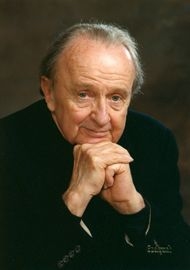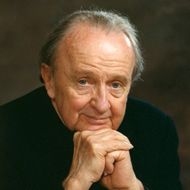Louis S. Osborne, a particle physicist whose cutting-edge research inspired colleagues and students alike, died Jan. 22 of congestive heart failure. A long-time resident of Lexington, Mass, Osborne was 88.
Osborne PhD '50 worked as an experimental physicist, using photons, electrons and neutrinos to probe matter. He performed some of the early and seminal experiments to measure the photo-production of mesons from nuclei and developed many of the experimental techniques that are now standard practice in high-energy physics.
His research provided experimental data that contributed to the confirmation of the unitary symmetry model, which is the periodic table of the particles affected by the strong force and is an important component of the current model of the fundamental particles and their interactions.
Physics Professor and Department Head Edmund Bertschinger described Osborne as a “gentle giant of physics — giant in his capacity to find and develop the best in people. He trained many leaders in physics and industry. We will miss him dearly.”
A native of Rome, Italy, Osborne received his BS from the California Institute of Technology, where he studied under Nobel Laureate Robert A. Millikan, famed for his oil drop experiment that measured for the first time the value of the elementary charge. After Caltech, Osborne served in the U.S. Navy, tending radar on an aircraft carrier in the Pacific. He arrived at MIT as a graduate student full of enthusiasm for physics, good humor and a love of all things Italian — qualities that never dimmed, according to colleagues.
“Lou embodied the joy of discovery. He was curious about everything and deeply committed to the big questions of high-energy physics,” said Frank Taylor, senior research scientist in the Laboratory for Nuclear Science.
Pondering pions
Osborne’s MIT career began with conducting research at the Laboratory for Nuclear Science in 1948 and with directing the MIT Synchrotron in 1950, where he carried out pioneering experiments in the photo-production of pions (pi-mesons), aiming to shed light on how these newly discovered subatomic particles are produced.
Later he worked with his students to develop the Differential Cerenkov Counter. Used to identify particles over a wide range of masses, the Cerenkov Counter has had important applications in the field of particle and nuclear physics.
Osborne joined the MIT faculty in 1959. In total, he devoted more than 50 years to understanding the fundamental building blocks of matter and the forces with which they interact.
“Lou was an outstanding hands-on experimental physicist, always at the cutting edge,” said Nobel Laureate Jerome Friedman, an Institute Professor emeritus and Osborne’s physics department colleague.
Osborne continued his pion photo-production studies at the Cambridge Electron Accelerator (CEA), which opened in 1962. Osborne welcomed the new facility with warmth, saying, “It was built with a marvelous attitude towards reliability … and with affection.”
His CEA experiments, carried out at higher energies, contributed “important information in clarifying a number of physics issues, including providing evidence for two new pion-nucleon resonances that contributed to the confirmation of unitary symmetry,” said Lawrence Rosenson, professor of physics emeritus, and an MIT colleague.
Osborne next joined Taylor, Rosenson and Friedman in an experiment at the Fermi National Accelerator Laboratory (Fermilab) near Chicago, studying deep-inelastic neutrino scattering from the nucleon. Their experiment provided an “important test of the Standard Model, our current model of the fundamental particles and their interactions,” noted Friedman.
Collaborations at the Stanford Linear Accelerator (SLAC) National Laboratory, the Superconducting Super Collider (SSC) in Texas and at CERN, the European Organization for Nuclear Research in Geneva, followed. Thanks to Osborne, “all these campaigns were great adventures,” Taylor said.
David Luckey, a CERN physicist and an MIT colleague for 20 years, said the highlight of his work with Osborne was “trying to build a magnetic detector for e+e-.” Luckey credits Osborne, a scientific associate at CERN for 10 years, with focusing on experiments that would later lead to advances in physics.
Fiddling with the knobs
Osborne’s ability to zero in on research with implications for the future made him an “ideal colleague and a terrific mentor of graduate students,” Rosenson noted.
Osborne served as thesis advisor to, among others, Burton Richter PhD ’56, a Nobel laureate and former SLAC director; Roy Schwitters PhD '70, a former SSC director; and Virgil Elings PhD '66, co-founder of Digital Instruments, which designed and sold scanning probe microscopes.
Osborne demanded his students develop confidence and independence — strengths of hand and mind crucial to sustaining world-class research. Elings had a physical encounter with this philosophy when his adviser once tore the wiring out of a device he was working on. “You can figure it out,” Osborne said.
“Lou believed in fiddling with the knobs, in doing it yourself. He was the first person to have such confidence in me,” Elings said.
Osborne’s lab in Building 24 fostered that "fiddle-with-the-knobs" ethos Elings found so inspiring. Odd but useful pieces of equipment lay about the basement room. It was “easy to do small experiments as well as design and build prototype muon tracking chambers,” Taylor said. “People who worked in that lab were happy to work with Lou.”
In addition to carrying out experiments, teaching and advising, Osborne had an excellent command of theory and published a number of phenomenological models. While at MIT, he was granted a Fulbright Award, a Guggenheim Fellowship and a Minna-James-Heineman Fellowship. He was a fellow of the American Physical Society and a member of the American Academy of Arts and Sciences.
Osborne is survived by his wife, Barbara (Schiller); his sons, Marc and Duncan; his son, Brian, and daughter-in-law, Isabelle; his stepchildren, Amy and Michael, and their spouses; two nieces and five grandchildren.
A memorial service will be held at the MIT Chapel on April 3, 2012, at 1:30 p.m. with a reception to follow in the Pappalardo Community Room (Building 4-349).
Contributions in Osborne’s honor may be sent to the MIT Office of Memorial Gifts.
Osborne PhD '50 worked as an experimental physicist, using photons, electrons and neutrinos to probe matter. He performed some of the early and seminal experiments to measure the photo-production of mesons from nuclei and developed many of the experimental techniques that are now standard practice in high-energy physics.
His research provided experimental data that contributed to the confirmation of the unitary symmetry model, which is the periodic table of the particles affected by the strong force and is an important component of the current model of the fundamental particles and their interactions.
Physics Professor and Department Head Edmund Bertschinger described Osborne as a “gentle giant of physics — giant in his capacity to find and develop the best in people. He trained many leaders in physics and industry. We will miss him dearly.”
A native of Rome, Italy, Osborne received his BS from the California Institute of Technology, where he studied under Nobel Laureate Robert A. Millikan, famed for his oil drop experiment that measured for the first time the value of the elementary charge. After Caltech, Osborne served in the U.S. Navy, tending radar on an aircraft carrier in the Pacific. He arrived at MIT as a graduate student full of enthusiasm for physics, good humor and a love of all things Italian — qualities that never dimmed, according to colleagues.
“Lou embodied the joy of discovery. He was curious about everything and deeply committed to the big questions of high-energy physics,” said Frank Taylor, senior research scientist in the Laboratory for Nuclear Science.
Pondering pions
Osborne’s MIT career began with conducting research at the Laboratory for Nuclear Science in 1948 and with directing the MIT Synchrotron in 1950, where he carried out pioneering experiments in the photo-production of pions (pi-mesons), aiming to shed light on how these newly discovered subatomic particles are produced.
Later he worked with his students to develop the Differential Cerenkov Counter. Used to identify particles over a wide range of masses, the Cerenkov Counter has had important applications in the field of particle and nuclear physics.
Osborne joined the MIT faculty in 1959. In total, he devoted more than 50 years to understanding the fundamental building blocks of matter and the forces with which they interact.
“Lou was an outstanding hands-on experimental physicist, always at the cutting edge,” said Nobel Laureate Jerome Friedman, an Institute Professor emeritus and Osborne’s physics department colleague.
Osborne continued his pion photo-production studies at the Cambridge Electron Accelerator (CEA), which opened in 1962. Osborne welcomed the new facility with warmth, saying, “It was built with a marvelous attitude towards reliability … and with affection.”
His CEA experiments, carried out at higher energies, contributed “important information in clarifying a number of physics issues, including providing evidence for two new pion-nucleon resonances that contributed to the confirmation of unitary symmetry,” said Lawrence Rosenson, professor of physics emeritus, and an MIT colleague.
Osborne next joined Taylor, Rosenson and Friedman in an experiment at the Fermi National Accelerator Laboratory (Fermilab) near Chicago, studying deep-inelastic neutrino scattering from the nucleon. Their experiment provided an “important test of the Standard Model, our current model of the fundamental particles and their interactions,” noted Friedman.
Collaborations at the Stanford Linear Accelerator (SLAC) National Laboratory, the Superconducting Super Collider (SSC) in Texas and at CERN, the European Organization for Nuclear Research in Geneva, followed. Thanks to Osborne, “all these campaigns were great adventures,” Taylor said.
David Luckey, a CERN physicist and an MIT colleague for 20 years, said the highlight of his work with Osborne was “trying to build a magnetic detector for e+e-.” Luckey credits Osborne, a scientific associate at CERN for 10 years, with focusing on experiments that would later lead to advances in physics.
Fiddling with the knobs
Osborne’s ability to zero in on research with implications for the future made him an “ideal colleague and a terrific mentor of graduate students,” Rosenson noted.
Osborne served as thesis advisor to, among others, Burton Richter PhD ’56, a Nobel laureate and former SLAC director; Roy Schwitters PhD '70, a former SSC director; and Virgil Elings PhD '66, co-founder of Digital Instruments, which designed and sold scanning probe microscopes.
Osborne demanded his students develop confidence and independence — strengths of hand and mind crucial to sustaining world-class research. Elings had a physical encounter with this philosophy when his adviser once tore the wiring out of a device he was working on. “You can figure it out,” Osborne said.
“Lou believed in fiddling with the knobs, in doing it yourself. He was the first person to have such confidence in me,” Elings said.
Osborne’s lab in Building 24 fostered that "fiddle-with-the-knobs" ethos Elings found so inspiring. Odd but useful pieces of equipment lay about the basement room. It was “easy to do small experiments as well as design and build prototype muon tracking chambers,” Taylor said. “People who worked in that lab were happy to work with Lou.”
In addition to carrying out experiments, teaching and advising, Osborne had an excellent command of theory and published a number of phenomenological models. While at MIT, he was granted a Fulbright Award, a Guggenheim Fellowship and a Minna-James-Heineman Fellowship. He was a fellow of the American Physical Society and a member of the American Academy of Arts and Sciences.
Osborne is survived by his wife, Barbara (Schiller); his sons, Marc and Duncan; his son, Brian, and daughter-in-law, Isabelle; his stepchildren, Amy and Michael, and their spouses; two nieces and five grandchildren.
A memorial service will be held at the MIT Chapel on April 3, 2012, at 1:30 p.m. with a reception to follow in the Pappalardo Community Room (Building 4-349).
Contributions in Osborne’s honor may be sent to the MIT Office of Memorial Gifts.







